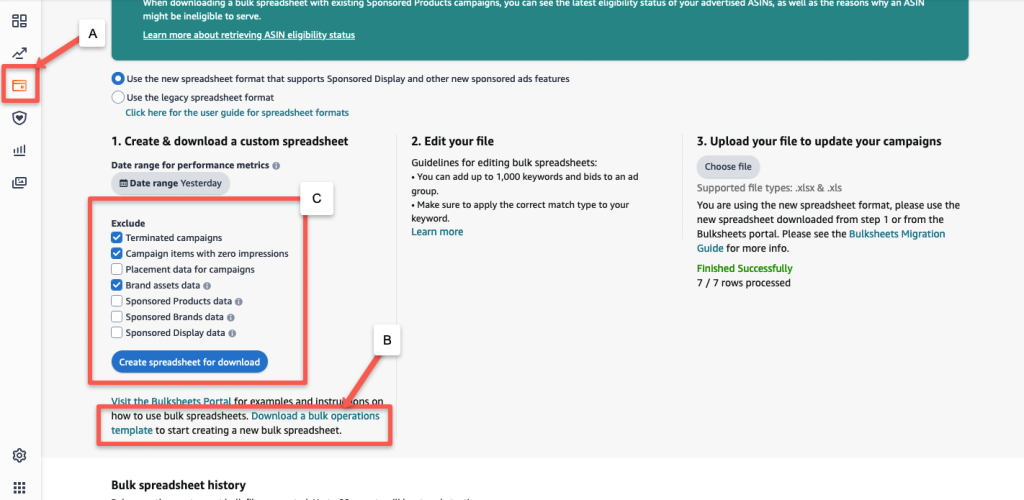You can manage your Amazon PPC campaigns by clicking through Amazon’s campaign manager, or you can use Amazon’s bulk operations. Bulk operations allow you to manage most aspects of your PPC by uploading a spreadsheet to Amazon instead of going into Seller Central’s Campaign Manager and manually managing or creating new campaigns.
Note: All articles will be about the NEW version of Bulksheets. Amazon’s official documents can be found here.
What Can You Do With Bulk Operations?
Bulk operations allow you to do anything you can do within the Campaign Manager. This includes, but is not limited to:
- Creating new campaigns
- Adding keywords and bids
- Adjusting bids
- Updating campaign details
- Starting and pausing campaigns
With Bulk Operations, you can create new campaigns and manage thousands of campaigns and keywords within minutes.
How To Get Started With Bulk Operations
After logging into Seller Central. Go to Advertising -> Campaign Manager. On the left sidebar click on Sponsored Ads -> Bulk Operations
You can download a spreadsheet from this screen with all your campaign data. You can also download a bulk operations template you can use to create your first bulk spreadsheet.
Are You a New Seller With No Campaign Data?
If you don’t have any ads set up yet, you can download a template from Bulk Operations by clicking the link “Download a bulk operations template“.
This template isn’t the most intuitive document to work with if you are new to Amazon, but Amazon does have a guide on what fields you need to include and explanations on each field that can be found here.
In upcoming articles, we will be providing information on how to create and manage campaigns, including the simplified and barebones spreadsheet we use when doing so. Sign up for our newsletter on our homepage to be notified when new articles are released.

B. Download the empty bulk operations template
C. Create a spreadsheet with all your existing campaign data
The Abundance of All Your Campaign Data
If you are an Excel or spreadsheet master, analyzing your campaign data can be done quickly by downloading all your campaign data. Here are some options when downloading your spreadsheet:
- Date Range – Today, Yesterday, 7, 14, 30, or 60 days’ worth of data
- Include or Exclude
- Terminated (archived) campaigns
- Campaign items with zero impressions
- Placement data for campaigns (columns “Placement Type” & “Increase bids by placement”)
- Brand assets data
- Sponsored Products/Brands/Display data
The spreadsheet contains 4 tabs:
- Portfolios (useful for finding the Portfolio ID)
- Sponsored Products Campaigns (keyword and product targeting)
- Sponsored Brand Campaigns (headline search and video ads)
- Sponsored Display Campaigns (a new Amazon ad unit!)
If you are not a spreadsheet master, this document can be overwhelming as it can include thousands if not hundreds of thousands of rows. Nevertheless, sorting and searching this document can still be quicker than finding the information you need using the traditional Campaign Manager interface.
Managing Existing Campaigns
Once you have your large spreadsheet you can make changes to your campaigns. You need to add the field “Update” or “Archive” to your Operations column, depending on the action you want to take.
For creating new campaigns, the “Create” operation would be used. The document that outlines all the required fields and options for the fields is Amazon’s “Bulksheets new version” document here.
Conclusion
So now that you know bulk operations exist, what do you do with them? Is it worth integrating them into your PPC management process? What are the benefits of using bulk spreadsheets and what’s the easiest way to get started?
We will answer these questions and more (including sample templates that we use for our own campaigns) in future articles. Sign up for our newsletter to make sure you don’t miss out.
